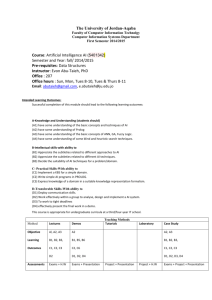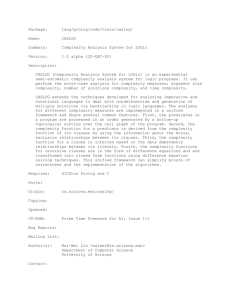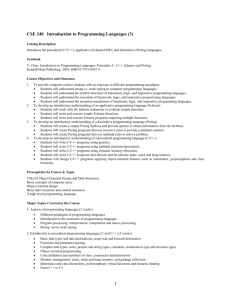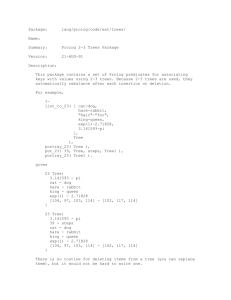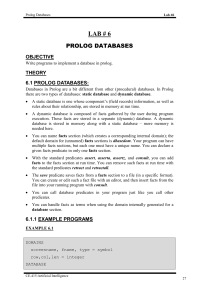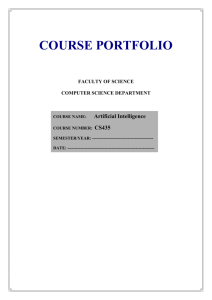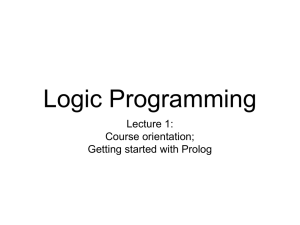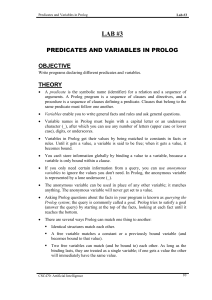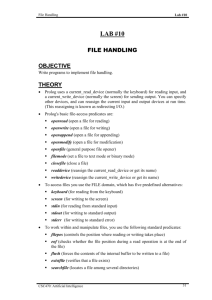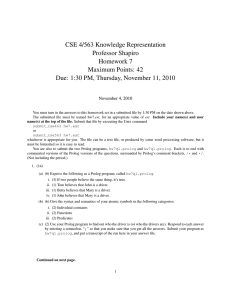Logic Programming
advertisement
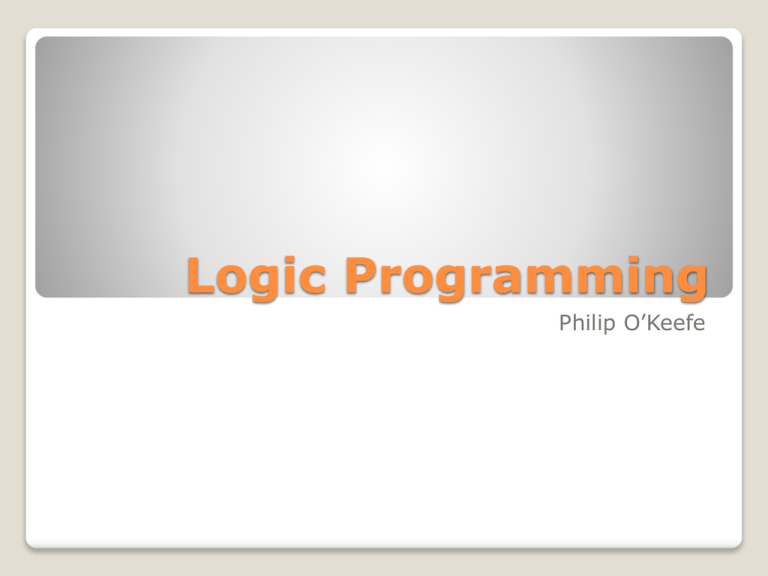
Logic Programming Philip O’Keefe Overview History Artificial Intelligence Logic Concepts Prolog Parts of Logic Programming Types of Logic Programming History Logic Programming can be traced back to 1958 by John McCarthy He proposed a hypothetical computer program named advice taker Probable first proposal to represent information as logic for a program John McCarthy A computer scientist Received Turing award for contributions in Artificial Intelligence Inventor of the LISP programming language Supported logic over procedural programming for AI Artificial Intelligence In 1960’s and 1970’s debates occurred about declarative versus procedural programming for AI Advocates for declarative were notably at Stanford including McCarthy Advocates for procedural were notably at MIT Artificial Intelligence Knowledge representation is one of the most important subareas of AI For an entity to behave intelligently it must be supplied sufficient knowledge This mean an unambiguous language capable of expressing this knowledge must be used This information must be able to be manipulated to answer queries A declarative language fits these requirements well Negation as Failure Related to the closed world assumption which is what is not currently known to be true is false In modern prolog negation as failure is written as not (p) It is different then logical negation Negation as Failure attempts to solve the goal p, if it cannot solve it as true then it is false Prolog Well known logic programming language Created in 1972 Prolog is a general purpose logic programming language associated with artificial intelligence Prolog is an abbreviation for programmation en logique which is french for programming in logic Prolog - Intro Prolog is essentially a query language Programs consists of three parts: list of facts, predicates and goals Relations and queries are constructed using Prologs single data type the Term Terms can be an atom, number, variable, or a compound term Generally a user submits a queries to try and prove a goal using the given predicates Prolog - Syntax The symbol :- represents “if” A comma represents “and” A period will end the statement Older version of prolog use \+ as logical negation “not” is used for negation as failure Prolog Hello World Here the ?- is the prompt for input in SWI-Prolog and the n1 is the newline character This statement in english is print Hello World and start a new line This would be equivalent to Java’s System.out.println(“Hello world\n”); “Yes” is appended to the result because statements must always evaluate to Yes/No or True/False General Example man(jim). man(fred). woman(X):\+( man(X) ). ?- woman(jim). No // fact 1 // fact 2 // relation of facts // query Logic Programming Languages Some other languages include: -Planner(MicroPlanner and PicoPlanner) -Popler -Ether -ALF -Curry -Oz The And-Or tree This tree represents the search space for solving problem P using the goal reduction method. Search space means the set of all possible solutions This tree states the following facts: -P if Q and R -P if S -Q if T -Q if U Problem Solving Backward Reasoning can determine a And-Or tree which constitutes the search space for solving a goal The top level goal is the root of the tree Many search strategies can be used on this tree Problem Solving There is alternative ways to execute a logic program This can be characterized by the equation Algorithm = Logic + Control Where logic is the program and Control is the theorem proving strategy Therefore many subsets of Logic Programming exist Abductive Logic Programming Abductive Logic Programming is a subset of normal logic programming This type of programming allows some predicates to be incompletely defined which are abductible predicates Problem solving is effected by deriving hypotheses on these abductible predicates as solutions of problems to be solved Constraint Logic Programming An extended form of logic programming to include constraints in the body of a clause For example take the statement ◦ A(X,Y) :- X+Y>0, B(X), C(Y) The literals A(X,Y) B(X) and C(Y) are part of normal logic programming To prove the goal A(X,Y) the constaint X+Y>0 must also be met Concurrent Constraint Logic Programming A version of constraint logic programming primarily aimed at programming concurrent processes Each process separately evaluates a goal Since multiple processes happen clauses now have the choice to include gaurds A guard is a boolean expression that should be evaluated to true for the execution to continue References http://www.cs.ttu.edu/~mgelfond/papers/survey.pdf http://www.doc.ic.ac.uk/~rak/papers/the%20early%20years.pdf http://computing.unn.ac.uk/staff/CGPB4/prologbook/node89.html http://clip.dia.fi.upm.es/~vocal/public_info/seminar_notes/node52.html http://books.google.ca/books?id=aWLHxtgZ18oC&dq=logic+programming+knowledge+representa tion&printsec=frontcover&source=bl&ots=Gff3psnrpJ&sig=2kv1UEfX_vxLWkSXJ_S5cPcKwKI&hl=e n&ei=wCroStH7L42GlAemg5mMCA&sa=X&oi=book_result&ct=result&resnum=5&ved=0CCwQ6AE wBA#v=onepage&q=&f=false http://www.csupomona.edu/~jrfisher/www/prolog_tutorial/pt_framer.html The End
